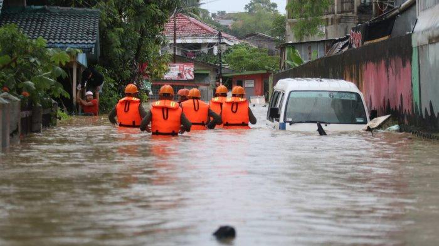Study of Flood Control in the Gang Mufakat of Balikpapan City (Qualitative Study)
Main Article Content
Abstract
Balikpapan City is a city that often experiences floods. One of the most frequently flooded locations is Gang Mufakat, which is located in Damai Village, South Balikpapan. This area is an area passed by the Ampal River Basin which is one of the causes of flooding besides the lack of vegetation as land cover in the settlement. This research aims to identify the management and control/control of floods in general. This is done to obtain information on several things that are considered important in management and to assess the understanding of the community and government regarding flood control/management. The research method used is a descriptive qualitative method. This research results from the community's understanding of floods and community actions in dealing with floods. Understanding of flooding in the form of causes of flooding, and the importance of the role of vegetation on land cover and the creation of infiltration wells. The recommendation for the government is to dredge sedimentation as well as deepen the Ampal watershed, and create a polder as a substitute for water catchment areas because there are many residential areas around the Ampal watershed which do not allow water to flow directly into the watershed. The recommendation for the community is to build an infiltration well in the Gang Mufakat.
Downloads Statistics
Article Details
 This work is licensed under a Creative Commons Attribution-NonCommercial 4.0 International License. Any further distribution of this work must maintain attribution to the author(s) and the title of the work, journal citation and DOI.
This work is licensed under a Creative Commons Attribution-NonCommercial 4.0 International License. Any further distribution of this work must maintain attribution to the author(s) and the title of the work, journal citation and DOI.
References
Iriani, K., Gunawan, A., & Besperi, B. (2013). Perencanaan sumur resapan air hujan untuk konservasi air tanah di daerah permukiman (studi kasus di Perumahan RT. II, III, dan IV Perumnas Lingkar Timur Bengkulu). Inersia: Jurnal Teknik Sipil, 5(1), 9-22.
Ka’u, A. A., Takumansang, E. D., & Sembel, A. (2021). Analisis Tingkat Kerawanana Banjir di Kecamatan Sangtombolang Kabupaten Bolaang Mongondow. Jurnal Spasial, 8(3), 291–302.
Marlina, S., & Novrianti, N. (2018). Identifikasi Pendangkalan Sungai Kahayan Akibat Sedimen. Media Ilmiah Teknik Sipil, 7(1), 35-42.
Moreng, J. I. T., Murdiyanto, M., & Oroh, H. V. (2020). Analisis Kerentanan Banjir di Daerah Aliran Sungai (DAS) Mede Kabupaten Halmahera Utara. Jurnal Episentrum, 1(2), 12-19.
Rahmawati, E., Rahmawati, A. W., Suripin, S., & Kurniani, D. (2017). Pengembangan Drainase Sistem Polder Sungai Sringin Kota Semarang. Jurnal karya teknik sipil, 6(1), 281-290.
Sulaiman, M. E., Setiawan, H., Jalil, M., Purwadi, F., Brata, A. W., & Jufda, A. S. (2020). Analisis Penyebab Banjir Di Kota Samarinda. Jurnal Geografi Gea, 20(1), 39-43.
Supriyati, S., Tjahjono, B., & Effendy, S. (2018). Analisis Pola Hujan untuk Mitigasi Aliran Lahar Hujan Gunungapi Sinabung. Jurnal Ilmu Tanah dan Lingkungan, 20(2), 95-100.

 PDF
PDF

 https://doi.org/10.32487/nuce.v2i1.435
https://doi.org/10.32487/nuce.v2i1.435







